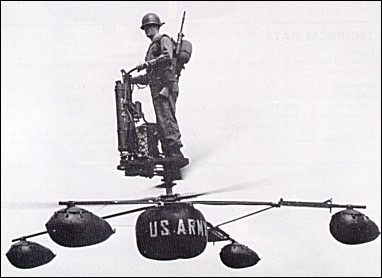|
|
The De Lackner DH-4 "Aerocycle" flying platform was the first of several one-man flying machines the Army evaluated during the late 1950s and early 1960s, and was certainly one of the more innovative of these various 'individual lift devices'. Developed by De Lackner as a private venture and originally named the "Heli-Vector", the DH-4 first flew in January 1955. The Army ordered twelve examples 'off-the-shelf' shortly thereafter. The aircraft was initially designated YHO-2 (a designation which was later also applied to five Hughes H-55 helicopter prototypes), though this was subsequently changed to HZ-1.
Like the somewhat similar Hiller VZ-1 "Pawnee", the Aerocycle carried its single pilot and 32kW engine on a circular platform located just above two belt-driven, contra-rotating fifteen-foot propellers. The engine throttle and a few basic instruments were attached to bicycle-type handlebars fixed to a three-foot tall pedestal atop the main platform. The pilot stood to the rear of the pedestal and was secured to it by safety belts, and guided his craft by simply leaning in the desired direction of travel. The machine's landing gear initially consisted of a single large air bag placed directly beneath the propellers and augmented by four smaller air bags fixed to outrigger bars, though this system was ultimately abandoned in favor of helicopter-type metal skids. The HZ-1 was surprisingly stable despite its rather ungainly appearance, and its top speed of more than 110kph made it considerably faster than most of the other unconventional one-man flying machines evaluated by the Army.
The Army's research into 'individual lifting devices' was intended to explore the feasibility of increasing the mobility of selected ground combat units by providing their members with inexpensive, safe, and easily operated personal aircraft. The Aerocycle was especially successful in the ease of operation category, for during the service tests soldiers required only about twenty minutes of instruction before flying the aircraft. However, the 'individual lifting device' concept was eventually deemed to be impractical in the light of then-current Army tactical doctrine and was abandoned, and the De Lackner Aerocycle thus became no more than an interesting footnote in the history of Army aviation.
| Technical data for De Lackner HZ-1
Crew: 1,
engine: 1 x Kieckhaefer Mercury Mark 55 rated at 32kW,
main rotor diameter: 4.57m,
height: 2.13m,
take-off weight: 206kg,
empty weight: 78kg,
max speed: 120km/h,
cruising speed: 90km/h,
service ceiling: 1520m
range: 24km
|
| Juan Luis Amilibia, e-mail, 30.11.2007 | reply |
Estoy interesado en toda clase de información sobre éste aparato |
|
| |
|
Do you have any comments ?
|
| 
Virtual Aircraft Museum

All the World's Rotorcraft
|







